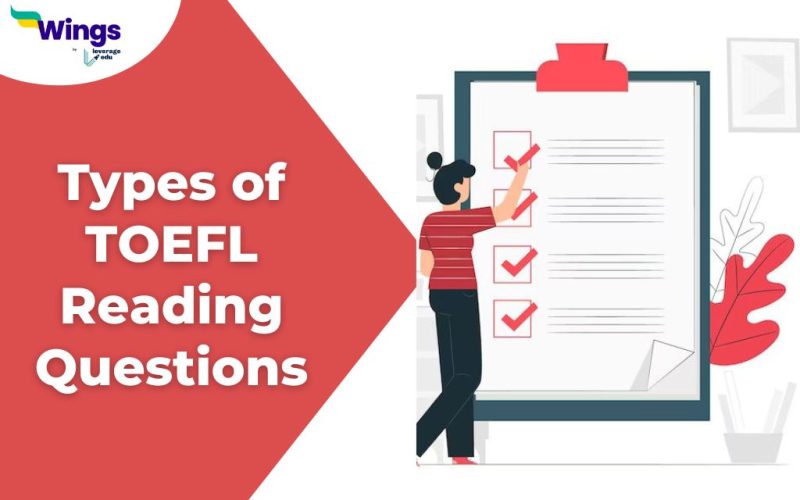Types of TOEFL Reading Questions: If you’re gearing up to take the TOEFL, the Reading section is a significant challenge you must conquer. Understanding the various question types is the key to navigating this section successfully. In this article, we’ll delve into the three primary TOEFL Reading question types, equip you with effective strategies, and address some common FAQs.
This Blog Includes:
TOEFL Reading Section: Types and Strategy
Approaching the TOEFL Reading section requires a two-fold strategy: identify the question type and employ effective guessing techniques if needed. While there are ten question types in total, focusing on the three main types will significantly boost your confidence and scores.
After allocating about 20 minutes per passage and utilizing reading strategies to enhance comprehension and speed, you’ll engage in the question-and-answer phase. Let’s explore how to discern the three pivotal question types within the TOEFL Reading section.
Must Read: TOEFL Exam 2023: Latest Updates, Format, Registration Process
Factual Questions
Factual questions are the friendliest question type because the answers are directly present in the passage. The TOEFL assesses your ability to locate and extract information the author has already provided. While seemingly straightforward, they can still be tricky.
These questions typically prompt you to find information from a specific part of the passage. For instance:
- “According to the passage, what is X?”
- “In paragraph 2, what does the author say about Y?”
Your first step is to thoroughly understand the question by identifying any crucial keywords. These questions usually fall under the “W/H” category, such as Who, What, Where, When, Why, and How. Quickly scan the passage for these keywords, identify the relevant passage section, and then select the accurate answer.
Remember:
- Carefully read all answer choices, as they might manipulate the relationship between keywords.
- Watch out for answer choices that aren’t present in the passage at all.
Inference Questions
Inference questions assess your ability to draw reasonable conclusions based on facts from the passage. Much like making an educated guess about spoiled milk, you infer from the provided facts. The TOEFL writers drop hints that guide you towards the correct answer.
Recognize inference questions through words like “imply,” “infer,” or “suggest.” They might also involve cause-and-effect relationships. Sample questions include:
- “Which of the following can be inferred about X?”
- “What is the author trying to imply about Y?”
To tackle these questions, carefully underline keywords in both the question and answer choices. Look for synonyms between them, which hint at relationships or concepts. Remember that the answers won’t be explicitly stated in the text. Eliminate choices that change meanings or contradict the passage, leaving you with a logical inference.
Summary Questions
Summary questions assess your ability to identify the most crucial ideas in a passage. These questions vary, from summarizing the entire passage to fitting a sentence into the right section. These questions aim to test how well you can pinpoint essential information.
Sample questions include:
- “Which of the following summarizes the essential information from the text?”
- “Where would this sentence best fit within the passage?”
To excel at summary questions, grasp the primary ideas in the passage—often located at the beginning and end. Pay attention to repeated concepts. Then, identify supporting details that help understand the main idea. Your task is to select the answer that best captures this essential information.
Also Read: TOEFL Study Material: Score High to Leverage Your Study Abroad Plans
FAQs
In the TOEFL Reading section, there are ten specific types of questions. However, focusing on the three primary question types—factual questions, inference questions, and summary questions—can significantly improve your performance and confidence.
TOEFL Reading questions are not necessarily presented in the order of the passage. They might refer to different parts of the passage, requiring you to navigate the text to locate the relevant information. This is why understanding question types and employing effective strategies is crucial.
A 2-point question in TOEFL Reading is a question where you need to select two correct answers out of the options provided. These questions are designed to test your ability to identify multiple correct pieces of information within the passage. Keep in mind that for these questions, selecting just one correct answer will not earn you any points.
The TOEFL Reading section typically consists of three or four reading passages, each followed by a set of questions. These passages are excerpts from academic texts, covering a range of subjects. The questions are designed to assess various skills, including factual understanding, inference, and summarization. The passage topics vary widely, but the question types remain consistent, allowing you to apply the strategies you’ve learned across different contexts.
Mastering the three core TOEFL Reading question types enhances your preparation and confidence. Next time you encounter unfamiliar words or tricky questions, think about these question types and strategies. Instead of succumbing to panic, use your knowledge to eliminate options and make educated guesses. Build a plan with Leverage Edu‘s Leverage Live classes and our top trainers to strengthen your English score as well as your application so that you can secure your spot in your dream college.
 One app for all your study abroad needs
One app for all your study abroad needs















 60,000+ students trusted us with their dreams. Take the first step today!
60,000+ students trusted us with their dreams. Take the first step today!